
Wine Culture and Information since 2002 - Volume 22
 Wine Culture and Information since 2002 - Volume 22 |
|
Issue 150, April 2016 |
Contents |
|
|
One Hundred and Fifty |
|
This month DiWineTaste celebrates a new important goal: issue number 150 - one hundred and fifty - of our publication. A journey began in 2002 - to be precise, 9 September 2002 at 10:10PM - when we uploaded by using FTP ((File Transfer Protocol) the first release of our web site and the first issue in PDF format (Portable Document Format). At those times, in fact, DiWineTaste was available in PDF format only and the Wine Guide would have been released few months later. It was a humble start, almost a whispered start, and I notified my friends about this new “adventure”, as well as wine producers of whom I had an e-mail address. With my surprise, many wine producers replied to this mail by sending their appreciation and wishes for the new magazine, most of them available to send their wines for a review. Many of them spread the word, something also helped by the Internet and search engines, and - at the end of October 2002 - that very first issue was read by a little more than two thousands people. One hundred and fifty DiWineTaste issues published in fourteen years - the fifteenth year will begin next October - in which we have written about wines and sensorial tasting. It was in fact my main goal to make of DiWineTaste a publication essentially about sensorial tasting, wine in particular. I have always believed the best way to understand a wine is to listen to it right from the glass, certainly not by reading other's words. In order to achieve this we need not only a wine - every wine, as they all have the same dignity - but also, and above all, the analytic cognition to understand it. Sensorial tasting, despite can be considered as a methodical technique leaving little or no space to emotions, certainly is the most efficient way to understand wine. Of course, wine is much more than this, a complex beverage that, last but not the least, is capable of giving emotions and pleasure. This is a very important aspect, nothing less than sensorial tasting technique, although it is about a different context. Since the first issue, DiWineTaste has always been focused on sensorial tasting and this subject has also been the main activity of our editorial and educational mission, also by having our readers involved in this aspect. Such us our events - a part existing since the day we started DiWineTaste - in which our readers meet producers, by listening to their stories and tasting their wines. I in fact believe the best way to understand a wine is always done by pouring it in a glass, taste and evaluate it according to our senses, something to be personally done. This is done, in particular, in an analytic and critical way, by using our senses, in order to better understand the nature of grapes, territories and producers. Of course, the emotional side of wine must not be forgotten, an essential characteristic, although it is essentially about personal and subjective perception instead of the context of objective understanding. One hundred and fifty DiWineTaste issues in which we focused on the many aspects of sensorial tasting, always aiming to give our readers the essential tools for the evaluation of wine. Sensorial tasting, in its technical nature and, for certain aspects to be considered an art because requires the use of senses, needs continuous practice and commitment. For this reason technical and theoretical knowledge are not enough in order to fully express this discipline and it must always and however supported by practice. In other words, the key to success for every taster certainly is the theoretical and technical knowledge but, above all, is to continuously tasting wines, of every style and quality. The first DiWineTaste issues have been mainly focused on technical and theoretical aspects of tasting, today, on the contrary, are mainly covered practical aspects, by suggesting our readers comparative study cases, as well as tasting by contrast. In these years we have also organized classes about wine and distillate sensorial tasting, as well as about enogastronomy. As a matter of fact, it is a sort of natural evolution of what we write in DiWineTaste, as theory cannot be enough in order to understand something. The same can be said about our application DiWineTaste Mobile for Android, iPhone and iPad, just another and modern way to use our publication. Our podcast can be seen with this very same point of view, a way giving our readers the chance of using DiWineTaste differently and by using different media. After all, by also considering my long career in software design and development, I think it is quite normal to implement these new media and ways. Nevertheless, it was right my mentality of software designer - in the many fields of computer technology I worked in - to make me believe since the beginning DiWineTaste should be available in Internet only. I have always believed in this choice, which came to my mind for the first time in 2000 and then realized in 2002 with the publication of the first issue of DiWineTaste. One hundred and fifty issues and fourteen years of DiWineTaste. A time and quantity maybe considered “important”, the result of a job done with commitment for a subject I am passionate about and interested in: sensorial tasting. Maybe, to be realistic, a pretty modest time and quantity if I look ahead and think about the future. When I think about what was DiWineTaste in 2002 and how it has become today, I admit it is quite hard to recognize it. Everything has changed since that initial idea, except for the PDF edition of the magazine, although adapted in the course of time. Another element which never changed since the first issue is the use of LATEX2ε in typesetting the magazine and from which are then created the pages in HTML format both for the website and mobile applications. Many things have changed and this is the sign of time going by, a sign things - unavoidably - are destined to change, as it is right to be. Another thing changed - and I am very proud of this - is the number of DiWineTaste readers. Whether the first issue counted a little more than 2000 readers, today the average number of readers is 155000. Maybe this is a little for some, maybe a lot for others, however I am aware of the fact that if this journey is still going on it is because of them. Thank you dear reader: the one hundred and fifty issues of DiWineTaste are dedicated to you. Antonello Biancalana
|
||||
Contrasts of Lambrusco Grasparossa and CroatinaProtagonists of wines having an immediate and direct character, the two red grapes of this month are widely used for the production of table and semi sparkling wines |
|
Semi sparkling wines have always played an important role in wine making and they are receiving a good appreciation from consumers. This wine style, different from fully sparkling wines, has always had alternate glory and their appreciation changed in the course of time and according to what producers were making. Semi sparkling wines - characterized by a lower pressure in the bottle than fully sparkling wines - are however successful and represent an important factor in wine market. Their consumption is typically associated to informal moments and to certain food traditions, to semi sparkling wines is usually recognized a lower prestige than the most “complex and joyous” sparkling wine. Irreplaceable companions of many Italian tables, semi sparkling wines certainly deserve a better consideration, while it should also be said - for the sake of truth - their quality is sometimes pretty low. According to the European directives, semi sparkling wines must have a pressure in the bottle of at least one atmosphere and not more than 2.5 at the temperature of 20 °C. For the sake of completeness, it should be noticed quality sparkling wines must have a minimum pressure of 3.5 atmospheres, 3 in case of generic sparkling wines. Semi sparkling wines are produced by using many techniques, of which the most common one is the fermentation in closed tank. In many cases, in particular for bulk wines, it is frequently used carbonation, that is adding carbon dioxide to a base wine. In Italy these wines are particularly common in the Po Valley, usually called “vivaci” (lively), and they are well matched to the cooking of those lands. Grapes belonging to the vast family of lambruschi, as well as Croatina, are particularly suited for the production of semi sparkling wines. For the sake of completeness, it should be said these grapes are also successfully used for the production of table wines. The family of lambrusco grapes is quite vast and its members are widely used for the production of semi sparkling wines, in particular in the western side of Emilia Romagna. Lambrusco grapes are also found in the eastern side of the region, however in this territory - the so called Romagna - wine making is mainly focused on table wines. Lambrusco has a very long history and it is considered one of the most ancient indigenous grapes of Italy, as it is a spontaneous wild plant already known at the times of ancient Romans. It is in fact believed Lambrusco directly originates from Vitis Vinifera Silvestre, that is spontaneous and wild, still common today and which gave origin to one of the most famous Italian wines. Virgil, Cato the Elder, Marcus Terentius Varro and Pliny the Elder have in fact written about Vitis Labrusca, although they did not mention wine making associated to this grape. It will be in the 1300s they will start writing about wines made from Lambrusco grape. In 1567 Andrea Bacci - personal doctor of pope Sixtus V - wrote that in the hills of Modena they were making wines from lambrusche grapes having a spicy and foamy character. The first one who worked on the classification of Lambrusco was Francesco Agazzotti - around the half of 1800s - and he identified the three main types: Lambrusco di Sorbara, Lambrusco Salamino and Lambrusco Grasparossa. To them will be then added Lambrusco Maestri, Lambrusco Viadanese, Lambrusco Montericco and Lambrusco Marani, as well as other less known types and having a marginal wine making use. Today Lambrusco is mainly produced by fermenting it in closed tank and made as dry, slightly sweet and sweet styles, both red and rosé. Lambrusco Grasparossa - protagonist of our tasting - is characterized by an intense and deep ruby red color with purple nuances, as well as a particular richness of aromas. This Lambrusco is the main variety used for the production of wines belonging to Lambrusco Grasparossa di Castelvetro DOC.
Croatina, the other grape protagonist of our tasting by contrast, is particularly common in the territory of Piacenza and Oltrepo Pavese. It is also found in Piedmont, Veneto and other areas of Lombardy. Croatina is sometimes confused with Bonarda - a grape of Piedmont and particularly common in the territory of Novara - as in Oltrepo Pavese and Piacenza this variety is frequently called with this name. It should be said Croatina has no connection with Piedmontese Bonarda and they are two distinct varieties. In wines of Oltrepo Pavese and Piacenza areas in which it is mentioned Bonarda, they are actually referring to Croatina. This variety is believed to have its origin in Rovescala, a town in province of Pavia and near Piacenza, where it is believed to be found in this area since the middle age. The first written mentions are dated back to the end of 1800s, when Croatina started to be spread in these areas. Croatina is mainly cultivated in the Denominazione d'Origine Controllata areas of Oltrepo Pavese and Colli Piacentini. It is also found in Piedmont and Veneto where it can also be used for the production of Valpolicella wines. In Lombardy is found in San Colombano al Lambro, the only DOC in the province of Milan. In Colli Piacentini, blended to Barbera and Uva rara, is used for the production of the most famous wine of this territory: Gutturnio. In Oltrepo Pavese, Croatina - here traditionally called Bonarda - is used for the production of table and semi sparkling wines, the latter style usually called vivace. In Oltrepo Pavese the semi sparkling style is more common than table wine, although this style too is certainly interesting, even though less common. Croatina is generally used for the production of wines for immediate consumption - therefore having a young and direct character - and usually vinified in inert containers such as steel tank. In order to spot differences even better, the wines of our tasting by contrast will belong to two different styles. The first wine is Lambrusco Grasparossa di Castelvetro Frizzante (Semi Sparkling) dry style. The production disciplinary for this wine provides for a minimum of 85% of Lambrusco Grasparossa and the remaining part can be other Lambrusco and Malbo Gentile grapes. The wine of our tasting needs to be made with 100% Lambrusco Grasparossa, or however having the highest possible percentage. The second wine of our tasting is Bonarda dell'Oltrepo Pavese and we need to make sure it is not the semi sparkling style and it must be vinified in inert containers. Also in this case we have to pay attention to its composition as the production disciplinary provides for a minimum 85% of Croatina and the remaining part of Barbera, Vespolina (here called Ughetta) and Uva Rara. Both wines will be of the last vintage in production and they will be served at the temperature of 16 °C (60 °F). The first wine of which we will evaluate appearance is Lambrusco Grasparossa di Castelvetro. As we pour the wine in the glass, we will notice the formation of abundant foam with a pink color, therefore confirming the well known liveliness character of this wine style. As soon as the foam is disappeared and it is possible to see the surface of wine, let's tilt the glass over a white towel. The color of this Lambrusco - observed at the base of the glass - reveals an intense ruby red hue, even deep, and a pretty low transparency. Nuances, observed at the edge of wine, towards the opening of the glass, show an intense purple color. Let's now pass to the evaluation of Bonarda dell'Oltrepo Pavese which, let's remind this again, is made from Croatina grape. By tilting the glass over a white surface, at the base we will see an intense ruby red color, with a higher transparency than Lambrusco. Nuances, observed at the edge of the wine towards the opening of the glass, show a ruby red color. The olfactory profiles of Lambrusco Grasparossa di Castelvetro and Bonarda dell'Oltrepo Pavese are characterized by fresh and intense aromas mainly recalling red and black fruits. Lambrusco Grasparossa gives the nose of the taster intense sensations of raspberry, cherry, strawberry, pomegranate and, frequently, almond. The profile of flowers is generally expressed by violet and cyclamen. In the aromas of Croatina are mainly recognized blackberry, cherry, plum, blueberry, raspberry and black cherry. Also in this grape can be appreciated aromas recalling flowers, in particular violet, cyclamen and rose. In Croatina can also be sometimes found the aromas of bitter almond. In this grape can also be common the aroma of strawberry and, sometimes, black currant. In Lambrusco Grasparossa - thanks to effervescence, therefore the effect of carbon dioxide - aromas will seem to have a pungent and crisp character. Let's start the analysis of aromas from Lambrusco Grasparossa di Castelvetro. Let's hold the glass in vertical position and, without swirling, proceed with the first smell in order to evaluate opening aromas. From the glass will be perceived aromas of cherry, raspberry and strawberry, a profile clearly recalling sensations of red and black fruits. After having swirled the glass, this operation will favor the formation of foam, therefore we need to wait for it to dissolve, let's do a second smell. The profile of Lambrusco Grasparossa di Castelvetro is completed by aromas of pomegranate, violet, cyclamen and a pleasing touch of almond. Let's now pass to the evaluation of Croatina's aromas expressed by Bonarda dell'Oltrepo Pavese. The opening of this wine gives blackberry, cherry and plum, as well as blueberry and violet. After having swirled the glass, the profile is completed by cyclamen, rose and, sometimes, black currant and almond. Let's now compare the two wines: carbon dioxide in Lambrusco Grasparossa will make its aroma seem “fresher” than those expressed by Croatina. The evaluation of taste in both wines will emphasize differences, in particular the role of carbon dioxide in the perception of other sensations. Let's start from Lambrusco Grasparossa di Castelvetro and take a sip of this wine. In the mouth we perceive the intense attack of the effervescence that, among the other things, contributes to the accentuation of acidity and astringency of tannins. The contribution of alcohol seems to be pretty modest: not only because the effect of the so called hard substances (effervescence, astringency and acidity) but also for the moderate content in alcohol, usually about 10.5%. Let's now pass to the tasting of Bonarda dell'Oltrepo Pavese, produced with Croatina. In the mouth it is perceived a completely different profile and the absence of carbon dioxide allows a better appreciation of the round characteristics of wine. The attack is however characterized by a pleasing crispness, with a sensation of moderate astringency allowing the perception of the pseudo burning effect of alcohol. The last phase of the tasting is about the final sensations the wines leave in the mouth after being swallowed and how they develop over time. After having swallowed Lambrusco Grasparossa di Castelvetro, let's evaluate its finish. This wine generally has a good persistence and leaves in the mouth flavors of cherry, raspberry and strawberry, as well as a pleasing perception of astringency and crispness. Two sensations, undoubtedly, inviting you to appreciate this wine again. The finish of Bonarda dell'Oltrepo Pavese - produced with Croatina - is characterized by a good persistence, leaving in the mouth flavors of blackberry, cherry and plum. Let's now compare the final sensations of the two wines, in particular body, astringency and acidity. Two immediate and pleasing wines certainly inviting you to take a new sip from their respective glasses. Two different characters, however good representatives of how a wine can also be agreeable and joyous, to be enjoyed for their exuberant and immediate fresh youth.
|
||||||||||||
Wines of the Month |
|
|
|
Score legend Prices are to be considered as indicative. Prices may vary according to the country or the shop where wines are bought |
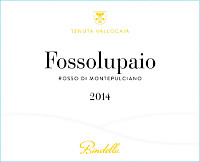
|
|
Rosso di Montepulciano Fossolupaio 2014 |
|
| Bindella (Tuscany, Italy) | |
 Sangiovese (85%), Syrah (15%) Sangiovese (85%), Syrah (15%) | |
| Price: € 9.00 | Score: |
 Brilliant ruby red and nuances of ruby red, moderate transparency. Brilliant ruby red and nuances of ruby red, moderate transparency. Intense, clean and pleasing, starts with hints of black cherry,
raspberry and cyclamen followed by aromas of violet, blueberry, carnation
and plum. Intense, clean and pleasing, starts with hints of black cherry,
raspberry and cyclamen followed by aromas of violet, blueberry, carnation
and plum.
 Properly tannic attack and however balanced by alcohol, good body,
intense flavors, pleasing crispness. Properly tannic attack and however balanced by alcohol, good body,
intense flavors, pleasing crispness.
 Persistent finish with flavors of black cherry, raspberry and
blueberry. Persistent finish with flavors of black cherry, raspberry and
blueberry.
 6 months in steel tanks, 3 months in bottle. 6 months in steel tanks, 3 months in bottle. |
|
 Cold cuts, Pasta with meat and mushrooms, Sauteed meat Cold cuts, Pasta with meat and mushrooms, Sauteed meat |
|
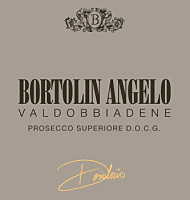
|
|
Valdobbiadene Prosecco Superiore Dry Desiderio 2014 |
|
| Bortolin Angelo (Veneto, Italy) | |
 Glera Glera | |
| Price: € 23.00 | Score: |
 Intense greenish yellow and nuances of greenish yellow, very
transparent, fine and persistent perlage. Intense greenish yellow and nuances of greenish yellow, very
transparent, fine and persistent perlage.
 Intense, clean, pleasing and refined, starts with hints of apple, peach
and wistaria followed by aromas of pear, pineapple, hawthorn, broom,
chamomile and tangerine. Intense, clean, pleasing and refined, starts with hints of apple, peach
and wistaria followed by aromas of pear, pineapple, hawthorn, broom,
chamomile and tangerine.
 Effervescent and crisp attack, pleasing sweetness, however balanced by
alcohol, light body, intense flavors, agreeable. Effervescent and crisp attack, pleasing sweetness, however balanced by
alcohol, light body, intense flavors, agreeable.
 Persistent finish with flavors of apple, peach and pear. Persistent finish with flavors of apple, peach and pear. Fermented in closed tank for 40 months. Fermented in closed tank for 40 months. |
|
 Cream desserts, Fruit desserts Cream desserts, Fruit desserts |
|
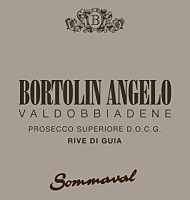
|
|
Valdobbiadene Prosecco Superiore Rive di Guia Brut Sommaval 2014 |
|
| Bortolin Angelo (Veneto, Italy) | |
 Glera Glera | |
| Price: € 25.00 | Score: |
 Brilliant greenish yellow and nuances of greenish yellow, very
transparent, fine and persistent perlage. Brilliant greenish yellow and nuances of greenish yellow, very
transparent, fine and persistent perlage.
 Intense, clean, pleasing, refined and elegant, starts with hints of
apple, pineapple and wistaria followed by aromas of pear, tangerine, broom,
hawthorn, peach, bread crust, sage and mineral. Intense, clean, pleasing, refined and elegant, starts with hints of
apple, pineapple and wistaria followed by aromas of pear, tangerine, broom,
hawthorn, peach, bread crust, sage and mineral.
 Effervescent and crisp attack, however balanced by alcohol, good body,
intense flavors, agreeable. Effervescent and crisp attack, however balanced by alcohol, good body,
intense flavors, agreeable.
 Persistent finish with flavors of apple, plum and pineapple. Persistent finish with flavors of apple, plum and pineapple. Fermented in closed tanks for 60 days. Fermented in closed tanks for 60 days. |
|
 Pasta and risotto with fish and crustaceans, Sauteed fish, Sauteed crustaceans, Dairy products Pasta and risotto with fish and crustaceans, Sauteed fish, Sauteed crustaceans, Dairy products |
|
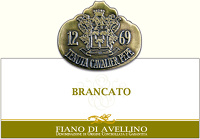
|
|
Fiano di Avellino Brancato 2013 |
|
| Tenuta Cavalier Pepe (Campania, Italy) | |
 Fiano Fiano | |
| Price: € 16.50 | Score: |
 Intense straw yellow and nuances of golden yellow, very transparent. Intense straw yellow and nuances of golden yellow, very transparent. Intense, clean, pleasing, refined and elegant, starts with hints of
apple, peach and hazelnut followed by aromas of pear, hawthorn, walnut
husk, pineapple, medlar, plum, broom, mineral and vanilla. Intense, clean, pleasing, refined and elegant, starts with hints of
apple, peach and hazelnut followed by aromas of pear, hawthorn, walnut
husk, pineapple, medlar, plum, broom, mineral and vanilla.
 Crisp attack and however balanced by alcohol, full body, intense
flavors, pleasing roundness. Crisp attack and however balanced by alcohol, full body, intense
flavors, pleasing roundness.
 Persistent finish with flavors of apple, peach and hazelnut. Persistent finish with flavors of apple, peach and hazelnut. 12 months in barrique, 10 months in bottle. 12 months in barrique, 10 months in bottle. |
|
 Roasted white meat, Stewed fish with mushrooms, Roasted fish Roasted white meat, Stewed fish with mushrooms, Roasted fish |
|

|
|
Taurasi Riserva La Loggia del Cavaliere 2008 |
|
| Tenuta Cavalier Pepe (Campania, Italy) | |
 Aglianico Aglianico | |
| Price: € 37.00 | Score: |
 Intense ruby red and nuances of garnet red, little transparency. Intense ruby red and nuances of garnet red, little transparency. Intense, clean, pleasing, refined and elegant, starts with hints of
plum, black cherry and dried violet followed by aromas of blueberry,
blackberry, vanilla, cocoa, tobacco, graphite, licorice, mace, leather and
menthol. Intense, clean, pleasing, refined and elegant, starts with hints of
plum, black cherry and dried violet followed by aromas of blueberry,
blackberry, vanilla, cocoa, tobacco, graphite, licorice, mace, leather and
menthol.
 Tannic attack and however balanced by alcohol, full body, intense
flavors, pleasing roundness. Tannic attack and however balanced by alcohol, full body, intense
flavors, pleasing roundness.
 Persistent finish with flavors of plum, black cherry and blackberry. Persistent finish with flavors of plum, black cherry and blackberry. 18 months in barrique, 12 months in bottle. 18 months in barrique, 12 months in bottle. |
|
 Game, Roasted meat, Stewed and braised meat, Hard cheese Game, Roasted meat, Stewed and braised meat, Hard cheese |
|
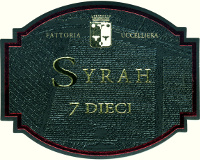
|
|
Syrah 7 Dieci 2014 |
|
| Fattoria Uccelliera (Tuscany, Italy) | |
 Syrah Syrah | |
| Price: € 23.00 | Score: |
 Intense ruby red and nuances of ruby red, little transparency. Intense ruby red and nuances of ruby red, little transparency. Intense, clean, pleasing and refined, starts with hints of black
currant, black cherry and violet followed by aromas of plum, blueberry,
black pepper, vanilla, chocolate and graphite. Intense, clean, pleasing and refined, starts with hints of black
currant, black cherry and violet followed by aromas of plum, blueberry,
black pepper, vanilla, chocolate and graphite.
 Properly tannic attack and however balanced by alcohol, good body,
intense flavors, agreeable. Properly tannic attack and however balanced by alcohol, good body,
intense flavors, agreeable.
 Persistent finish with flavors of black currant, black cherry and
blueberry. Persistent finish with flavors of black currant, black cherry and
blueberry.
 A part ages for 12 months in cask. A part ages for 12 months in cask. |
|
 Broiled meat and barbecue, Roasted meat, Stewed meat with mushrooms, Cheese Broiled meat and barbecue, Roasted meat, Stewed meat with mushrooms, Cheese |
|
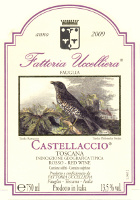
|
|
Castellaccio 2009 |
|
| Fattoria Uccelliera (Tuscany, Italy) | |
 Sangiovese (60%), Cabernet Sauvignon (40%) Sangiovese (60%), Cabernet Sauvignon (40%) | |
| Price: € 21.00 | Score: |
 Intense ruby red and nuances of brick red, little transparency. Intense ruby red and nuances of brick red, little transparency. Intense, clean, pleasing, refined and elegant, starts with hints of
plum, black currant and dried violet followed by aromas of black cherry,
blueberry, vanilla, tobacco, licorice, chocolate, leather, mace and
eucalyptus. Intense, clean, pleasing, refined and elegant, starts with hints of
plum, black currant and dried violet followed by aromas of black cherry,
blueberry, vanilla, tobacco, licorice, chocolate, leather, mace and
eucalyptus.
 Tannic attack and however balanced by alcohol, full body, intense
flavors, agreeable. Tannic attack and however balanced by alcohol, full body, intense
flavors, agreeable.
 Persistent finish with flavors of plum, black currant and black cherry. Persistent finish with flavors of plum, black currant and black cherry. 14 months in barrique, 12 months in bottle. 14 months in barrique, 12 months in bottle. |
|
 Game, Roasted meat, Stewed and braised meat, Hard cheese Game, Roasted meat, Stewed and braised meat, Hard cheese |
|
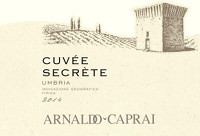
|
|
Cuvée Secrète 2014 |
|
| Arnaldo Caprai (Umbria, Italy) | |
 n.d. n.d. | |
| Price: € 30.00 | Score: |
 Brilliant greenish yellow and nuances of greenish yellow, very
transparent. Brilliant greenish yellow and nuances of greenish yellow, very
transparent.
 Intense, clean, pleasing, refined and elegant, starts with hints of
peach, pear and banana followed by aromas of gooseberry, apple, citrus
fruits, plum, broom, acacia, nettle, elder, mineral and hints of vanilla. Intense, clean, pleasing, refined and elegant, starts with hints of
peach, pear and banana followed by aromas of gooseberry, apple, citrus
fruits, plum, broom, acacia, nettle, elder, mineral and hints of vanilla.
 Crisp attack and however balanced by alcohol, good body, intense
flavors, agreeable. Crisp attack and however balanced by alcohol, good body, intense
flavors, agreeable.
 Persistent finish with flavors of apple, peach and banana. Persistent finish with flavors of apple, peach and banana. 6 months in barrique, 4 months in bottle. 6 months in barrique, 4 months in bottle. |
|
 Pasta with meat, Roasted white meat, Roasted fish, Legume soups Pasta with meat, Roasted white meat, Roasted fish, Legume soups |
|
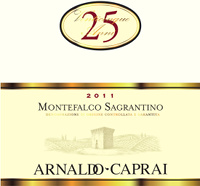
|
|
Montefalco Sagrantino 25 Anni 2011 |
|
| Arnaldo Caprai (Umbria, Italy) | |
 Sagrantino Sagrantino | |
| Price: € 50.00 | Score: |
 Brilliant ruby red and nuances of garnet red, little transparency. Brilliant ruby red and nuances of garnet red, little transparency. Intense, clean, pleasing, refined and elegant, starts with hints of
blackberry, black cherry and violet followed by aromas of plum, blueberry,
vanilla, peony, chocolate, tobacco, cinnamon, mace, pink pepper, leather
and menthol. Intense, clean, pleasing, refined and elegant, starts with hints of
blackberry, black cherry and violet followed by aromas of plum, blueberry,
vanilla, peony, chocolate, tobacco, cinnamon, mace, pink pepper, leather
and menthol.
 Tannic attack and however balanced by alcohol, full body, intense
flavors, agreeable. Tannic attack and however balanced by alcohol, full body, intense
flavors, agreeable.
 Very persistent finish with long flavors of blackberry, black cherry
and plum. Very persistent finish with long flavors of blackberry, black cherry
and plum.
 24 months in barrique, at least 8 months in bottle. 24 months in barrique, at least 8 months in bottle. |
|
 Game, Roasted meat, Stewed and braised meat, Hard cheese Game, Roasted meat, Stewed and braised meat, Hard cheese |
|
News |
|
In this section are published news and information about events concerning the world of wine and food. Whoever is interested in publishing this kind of information can send us a mail to our address.
|
AquavitaeReview of Grappa, Distillates and Brandy |
|
|
||||||||||||||
Wine Guide ParadeJanuary 2016
|
| |||||||
Privacy Policy | |||||||


| Copyright © 2002-2024 Antonello Biancalana, DiWineTaste - All rights reserved |
| All rights reserved under international copyright conventions. No part of this publication and of this WEB site may be
reproduced or utilized in any form or by any means, electronic or mechanical, without permission in writing from DiWineTaste. |